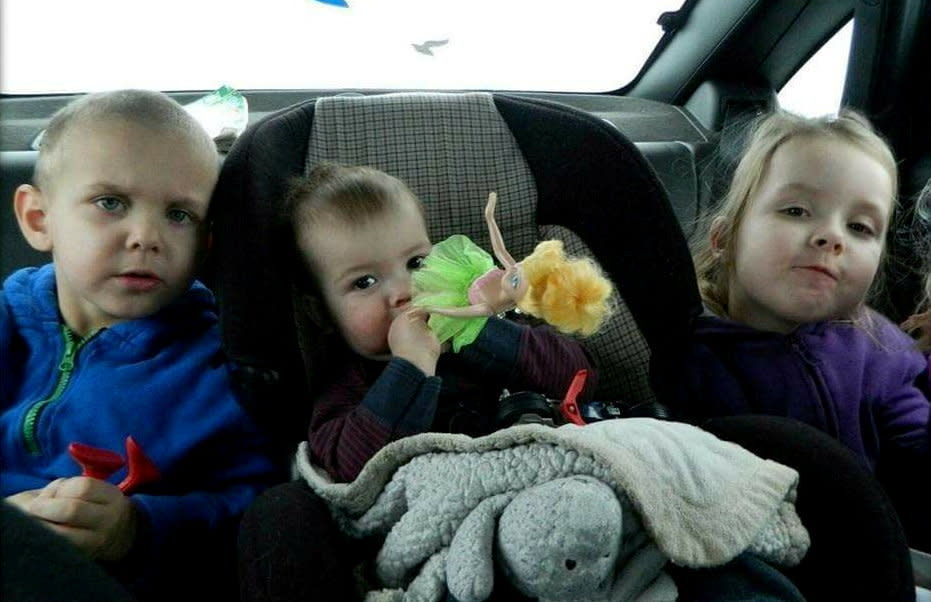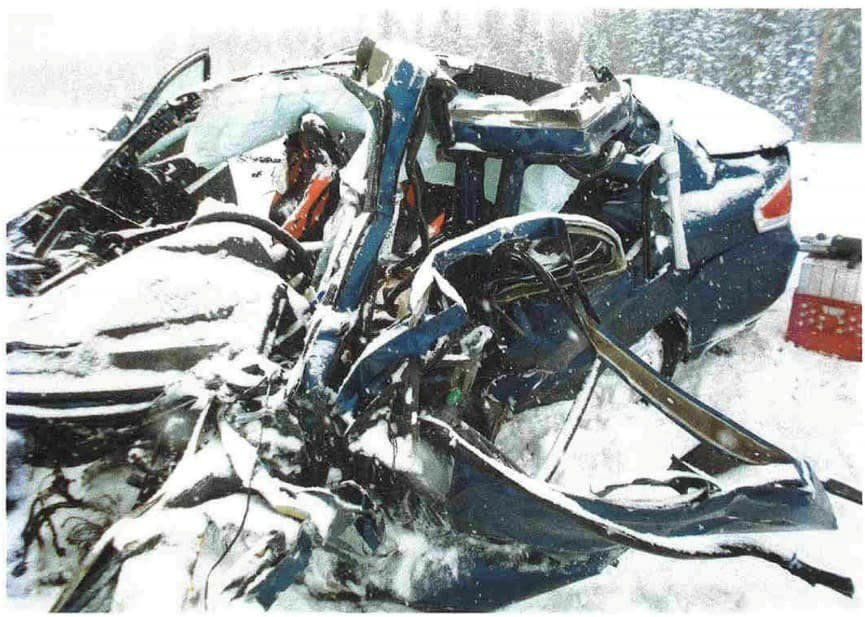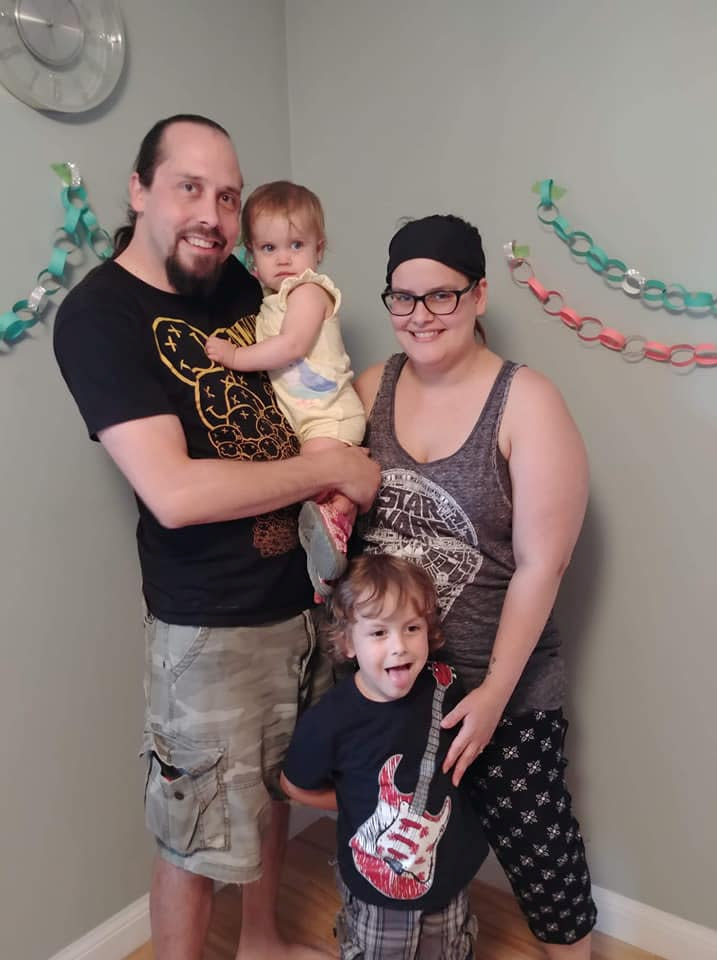Mum shares heartbreaking last picture of her children in car before two died in a collision

A mum campaigning for tighter child car seat laws has shared the last photo of her children, taken in a car just 20 minutes before two were tragically killed in a crash.
Eran Jones, now 32, survived the head-on collision in 2013 that killed her children Hailie Michaud, four, and 17-month-old Trent Michaud, as well as her sister-in-law Christine, 23.
Jones and son Owen, then three, were only saved because quick-thinking Christine swerved into a ditch.
All three kids were correctly strapped into legally approved car seats at the time of the crash, but Jones believes all her children may have survived if car seat rules were more rigid.
Since the tragedy, the mum has been campaigning for tighter laws on children’s car seats and now works as a voluntary car seat technician helping families make a safe choice for their kids.
Read more: The child seat mistake most parents are making
Speaking about the accident, Jones, from New Brunswick, in Canada, said that the last thing she remembers her sister-in-law saying was that she was going to head towards the ditch.
“I remember her taking the ditch,” she says. “It went blank for a quarter of a second because we spun. I have no idea how many times we spun – I think about 10 or 15 times.”
Though she was moving in and out of consciousness, Eran remembers hearing Trent gasping for breath.
“It's hard to explain how it feels to hear your baby cry in that way – I have no words to describe that feeling,” she says.

The family were on their way from Slave Lake to Edmonton, in Alberta, on 20 March, 2013, on the day of the crash. Although it was snowing Christine was experienced at driving in winter weather, and they were “taking it slow”.
Jones snapped a photo of the three children in the back seat during a break, halfway through their journey.
Back on the road, with everyone secured in their seats, they spotted an oncoming truck pulling out into their lane as it passed a transport truck in front.
They were travelling on a two-lane road, and though Christine tried to swerve off the road, they were hit head-on, causing the the car to spin multiple times.
Read more: It’s dangerous for children to wear a coat in their car seat
Jones says she knew immediately that Christine was dead by the way her hand fell from the steering wheel.
She could hear Owen screaming, but she couldn’t see or hear her daughter Hailie.
It was only later Jones learned that Hailie, four, died after suffering internal organ damage when she slid under the driver's seat – called the submarine effect because she slid under the lap restraint.
She had been in a no-back booster seat behind Christine, and Jones believes her daughter may have survived had she been in a five-point harness car seat.
Trent died from internal spinal decapitation, which Jones believes was caused because he was facing forward.
He was in a five-point harness seat – she argues that because he was under two, he would have been kept safer by a rear-facing seat.
Owen, now 10, survived, but suffered a catalogue of injuries including a broken arm, collapsed lungs and a ruptured spleen.
He was in a no-back booster seat, but his mum believes his injuries may have been lessened if he had been in a five-point car seat.
Eran is sharing her story in the hope that parents will be encouraged to campaign for tighter car seat rules.
She has been a voluntary car seat technician since 2018, and has been fighting lawmakers to raise the minimum legal requirements for children in cars.
She wants it to be law for under-twos to be in rear-facing seats, raise the minimum age for a booster seat to at least five, and for boosters to be used until kids are 145cm.
But different car seat rules apply in the UK (see below).
Jones credits Christine with saving her life, and is continuing the car seat safety fight in her name too.
“If she hadn't swerved towards the ditch, I wouldn't be here now,” she said.
“I shouldn't be here, but I am.
“That's why I'm doing what I'm doing.
“It's helping parents around the world.
“There have been times when I have had around 100 UK parents message me in a few days, asking ‘am I doing this right? or how do I get help?’.
“I'm not certified to help people in the UK, but I can tell them where to go get help.”

The UK laws on child car seats
According to the UK government, children must use a car seat until they are 12 years old or 135cm tall – whichever comes first.
Once they have outgrown the seat, children are required by law to wear a seatbelt at all times.
Height-based car seats
Height-based car seats are referred to as ‘i-Size’ seats. According to UK laws, they must be rear-facing until the child is over 15 months old. Then they may be switched to a forward-facing seat.
It is important to check that the car seat is suitable for the height of your child. Only EU-approved child car seats can be used in the UK, and come with a label that depicts a capital “E” in a circle and “R129”.
Weight-based car seats
When choosing a car seat for your child, it’s important to consider their weight.
Only EU-approved weight-based car seats can be used in the UK and these bear a label which has a capital “E’ and ‘ECE R44”.
Further information on choosing the correct car seat can be found on Gov.uk.
How to fit a child’s car seat
Parents must only use a child car seat if the car’s seat belt has a diagonal strap, unless the seat meets the following criteria:
It is specifically designed for use with a lap seat belt
It is fitted using ISOFIX anchor points
You must deactivate the car’s front airbags before fitting a rear-facing baby seat in a front seat and must not fit a child car seat in side-facing passenger seats.
Further information on choosing the correct car seat can be found here.



